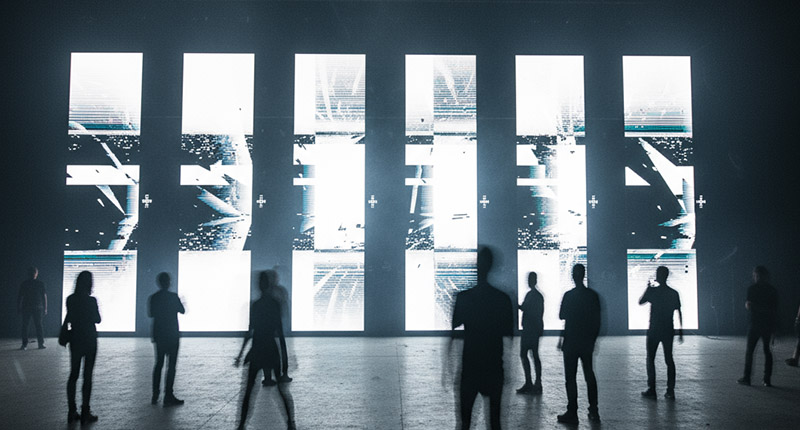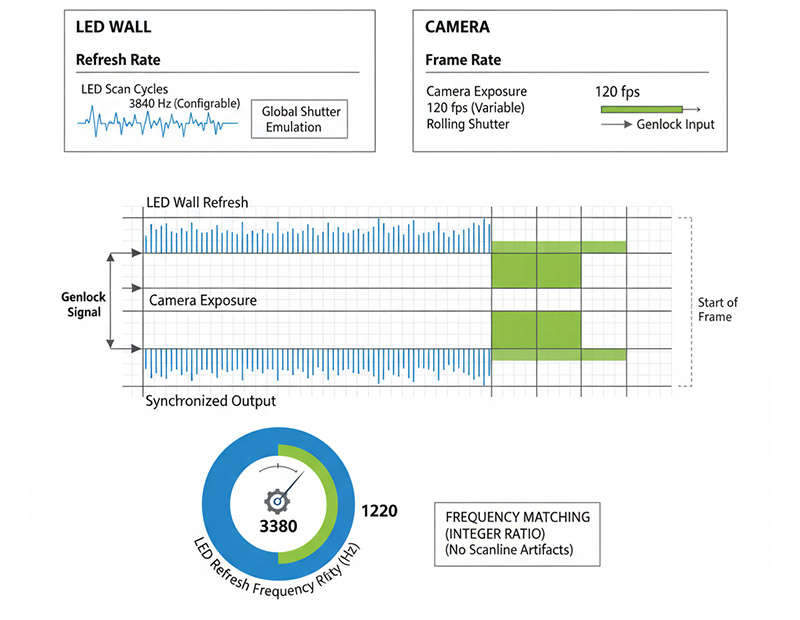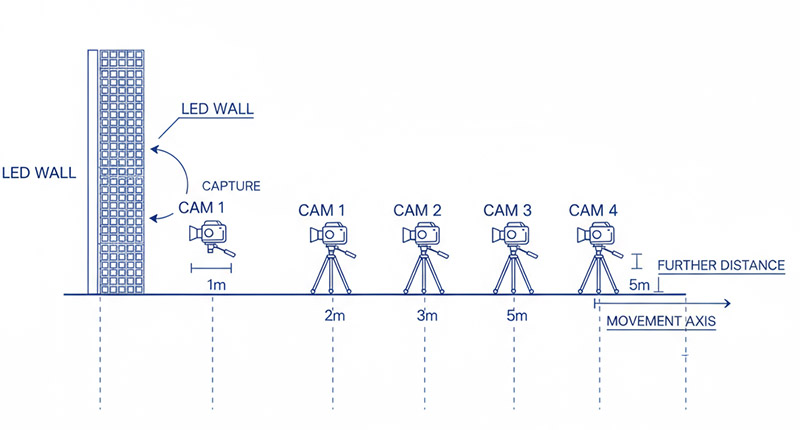Ever tried filming a subject in front of a massive LED wall, only to watch the background turn into a flickering, kaleidoscopic mess? Welcome to the world of LED‑wall shooting – where camera timing and display timing often clash, producing either pulsing “strobe” or the infamous moiré pattern.

In this guide we will:
1.Explain why LED walls are prone to visual artifacts.
2.Describe the two most common problems: stroboscopic effect Und moiré.
3.Provide concrete solutions, both technical and practical.
4.Share professional tricks and a step‑by‑step troubleshooting workflow.
Why LED Walls are Troublemakers
An LED wall is a giant grid of light‑emitting diodes (LEDs). The wall’s refresh rate (how many times the grid updates per second) and the camera’s Bildrate (how many frames it captures per second) are independent timing systems. When the two frequencies are close but not perfectly aligned, the result is either:
• a rapid pulsing or “strobe” of the background (stroboscopic effect), or
• a set of new wavy or pixelated patterns (moiré).
Think of it as two drummers beating at slightly different tempos—instead of harmony you get visual noise.
Stroboscopic Effect: The Unwanted Light Show
What is Stroboscopic Effect?
Der stroboscopic effect appears when the camera captures the LED wall during its “on/off” cycles. If the camera’s shutter samples a mix of “on” and “off” states.
The LED wall doesn’t actually display content continuously; it refreshes rapidly, typically 50-60 times per second (or faster). Your camera also takes pictures at specific intervals, usually 24, 30, or 60 frames per second. When these two frequencies don’t align perfectly, you get the visual equivalent of two metronomes ticking at slightly different speeds – the result is a pulsing or flickering effect that can make the entire wall appear to strobe or flicker.
Why Does This Happen?
LED walls use a technique called PWM (Pulse Width Modulation) to control brightness levels. Instead of varying the voltage, they turn the LEDs on and off very quickly, with the ratio of “on” time determining how bright each LED appears.
Think of it like trying to photograph a blinking light with a camera. If you catch it while it’s on, it’s bright. If you catch it while it’s off, it’s dim. If you catch it right as it’s transitioning, you get inconsistent brightness across the frame. Now multiply this by millions of LEDs, and you can see why things get complicated.
Moiré Pattern: The Interference Nightmare
What is Moiré Pattern?
Moiré is an interference pattern created when two periodic grids—
In LED wall shooting, moiré patterns occur when your camera’s sensor grid (the pixel array) interacts with the LED wall’s grid structure. Both are essentially repeating patterns of light and dark areas, and when they don’t align perfectly, they create new patterns that can make the wall appear to have wavy, swirling, or even pixelated effects that weren’t there in the original content.
The Mathematics Behind the Madness
Moiré is a manifestation of beat frequency: the difference between two spatial frequencies (the camera’s pixel pitch and the wall’s LED pitch). When two frequencies are close but not identical, they create a new frequency that’s the difference between them.
When your camera’s pixel pitch (the distance between pixels on your sensor) is roughly 1-3 times the LED pitch (the distance between LEDs on the wall),the interference becomes strongest, you’re in the danger zone.
Solutions: How to Fight Back
Below is a consolidated toolbox. Choose the combination that works best for your setup.
Tackling Stroboscopic Effects
| Method | How it works | Tips |
| Frame‑rate alignment | Match your camera’s fps to the wall’s refresh rate (e.g., 60 Hz → 60 fps; 30 fps if the wall can sync). | Verify the actual refresh rate; some walls can output multiple rates depending on content. |
| Shutter speed (narrower angle) | Shorten exposure so each frame sees a single LED state. | Expect higher ISO or more lighting to compensate. |
| Global‑shutter cameras | All pixels are read simultaneously, reducing “mixing” of LED states. | They are costlier but often worth it for critical shoots. |
| Readout modes (ERS/rolling‑shutter optimization) | Some cameras offer faster sensor readouts that can “skip” problematic cycles. | Check your camera’s menu for “fast readout” or “electronic shutter” options. |
| Increase distance & angle | Greater camera‑wall separation reduces the proportion of the wall within the sensor’s field of view, lowering the chance of timing clashes. | A few extra meters can make a dramatic difference. |
| ND filters / aperture tweaks | Minor optical attenuation can dampen flicker without changing timing. | Use sparingly; they may reduce overall brightness. |
Conquering Moiré Patterns
| Method | How it works | Tips |
| Adjust distance & angle | Small changes (a few centimeters or a slight rotation) move the sensor‑grid relationship out of resonance. | Test incrementally; results can vary dramatically across inches. |
| Light defocus (slight out‑of‑focus) | A small focus blur smooths the interference pattern without softening the subject. | Keep blur minimal; over‑defocus can make the wall look hazy. |
| Pixel‑shift or sensor‑shift | Shifting the sensor (or using pixel‑shift technology) changes the sampling lattice relative to the LED grid. | Useful on high‑end mirrorless/DSLR models that support this. |
| Resolution mismatch | Choose a camera whose pixel count does not divide evenly into the wall’s pixel count (or vice‑versa). | If the wall is 1920×1080, a 24‑MP sensor often avoids the 1:1 ratio. |
| Dedicated “camera‑friendly” mode | Some LED walls have a mode that switches the PWM frequency to a pattern less likely to cause interference. | Expect a slight drop in color fidelity; test before shooting. |
Advanced Techniques and Professional Tricks
The Sweet Spot Method
Professional cinematographers often locate a sweet‑spot distance—a location where both stroboscopic and moiré artifacts are minimized. Achieving it typically requires a few test shots, but the result can differ markedly from positions just a few inches away.
Electronic Solutions
LED‑wall camera‑friendly presets – many manufacturers offer “broadcast” or “studio” modes that modify PWM and refresh patterns.
Real‑time synchronization – some high‑end systems can lock the wall’s refresh to the camera’s frame timing (e.g., Genlock or PTP), eliminating flicker outright.
Lighting Balance
Use additional lights (softboxes, panels, or reflectors) to blend with the wall’s own illumination. Balancing the overall exposure reduces the perceived impact of any residual strobe or moiré, especially when the wall’s content is dynamic.
Troubleshooting Workflow: Your Step-by-Step Guide
| Step | Action | What to Look For |
| 1️⃣ Pre‑shoot assessment | Review wall specs: refresh rate (Hz), pixel pitch, available “camera‑friendly” modes. | Note whether the wall can switch to 60 Hz, 50 Hz, 120 Hz, etc. |
| 2️⃣ Test shots | Shoot at various fps/shutter combos (e.g., 24 fps + 1/48 s, 30 fps + 1/60 s, 60 fps + 1/120 s). | Observe flicker intensity; choose the setting with the least visible strobe. |
| 3️⃣ Positioning experiments | Start close, then move the camera away; also try slight angles (5–10°). | Note any moiré patterns; keep the subject in focus while adjusting. |
| 4️⃣ Fine‑tuning | Make micro‑adjustments to distance, angle, and focus to minimise both artifacts simultaneously. | Ideally the wall should be smooth, and the subject crisp. |
| 5️⃣ Content check | Verify the wall’s content (fast motion, high‑frequency patterns, solid colors) reacts differently. | For high‑frequency patterns, consider using a slight defocus or a higher‑resolution camera. |
Future Developments: What’s Coming Next
Technology is constantly evolving. We’re seeing LED walls with higher refresh rates, better camera compatibility modes, and systems that automatically adjust based on detected camera settings. Camera technology is also advancing rapidly, with new sensors using sophisticated processing algorithms to minimize electronic artifacts in-camera.
Real-World Application Examples
Event Production: When filming a live concert with LED stage backgrounds, the goal is often to have the audience perceive a seamless visual experience while capturing broadcast-quality footage for streaming or recording.
Firmenveranstaltungen: LED walls are increasingly common in corporate presentations, where executives might need to be filmed speaking in front of dynamic, branded backdrops.
Film and Television: From futuristic sci-fi scenes to contemporary dramas set in offices or homes, LED walls offer unprecedented flexibility in creating backgrounds that can change instantly.
Conclusion: Your Journey to LED Wall Mastery
LED wall shooting is fundamentally about understanding the relationship between camera sensors and LED display grids. The technical challenges of stroboscopic effects and moiré patterns require both technical knowledge and creative problem-solving skills.
Key Tkeaways:
• Stroboscopic effects occur when camera frame rates conflict with LED wall refresh rates; solution: match frame rates or adjust shutter speeds
• Moiré patterns result from sensor and LED grid interference; solution: change camera position, angle, or use slight defocus
• Distance is your friend – small positional adjustments can dramatically improve results
• Test extensively – each LED wall setup responds differently to camera settings
Content awarenessManche LED-Inhalte sind von Natur aus kamerafreundlicher als andere.
Durch die Anwendung dieser Prinzipien – das Verstehen des Timing-Konflikts, das Einsetzen geeigneter technischer Korrekturen und das Experimentieren mit der Positionierung – können Sie LED-Wandaufnahmen von einer technischen Herausforderung in ein wirkungsvolles kreatives Instrument verwandeln.






